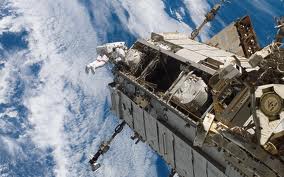Throughout the history of astronomy, the Hubble telescope has been on of the most crucial inventions. The Hubble telescope has enabled astronomers to look farther into the universe than any telescope before. In addition, the Hubble telescope has allowed us to see far away objects more clearly than any other preceding telescope. When it is utilized beyond the earth’s atmosphere, astronomers can see objects even further away. The reason for this is because ultraviolet and infrared spectra are absorbed considerably through the earth?s atmosphere. These spectra play an important role in not only observing objects far away but also being able to see them clearly. Therefore, by transferring the observing system into outer space, the Hubble telescope will offer a clearer view and enable scientists to see objects further away.
Background Of The Hubble Telescope
 The Hubble telescope is named after Edwin Hubble. Hubble was the astronomer who initially stated that the universe is expanding. The discovery of the universe expanding is one of the foundations of modern astronomy. Thus, Edwin Hubble has contributed to astronomy considerably. Although, Lyman Spitzer first thought of the idea of using telescopes beyond the earth’s atmosphere in 1946. He noticed that earth-based telescopes are restricted in their ability to see into outer space, because clouds, dirt and even turbulence within the atmosphere interfere with the clarity. Between 1966 and 1972, smaller sized Orbiting Astronomical Observatory satellites had experienced success in gathering images in outer space. This success led to plans being proposed for a large-scale telescope beyond the earth’s atmosphere. However, budget cuts put a damper on the project. Funding for the larger telescope was not approved until 1978. With the approved funding, strategies were produced to launch the Hubble telescope in 1983.
The Hubble telescope is named after Edwin Hubble. Hubble was the astronomer who initially stated that the universe is expanding. The discovery of the universe expanding is one of the foundations of modern astronomy. Thus, Edwin Hubble has contributed to astronomy considerably. Although, Lyman Spitzer first thought of the idea of using telescopes beyond the earth’s atmosphere in 1946. He noticed that earth-based telescopes are restricted in their ability to see into outer space, because clouds, dirt and even turbulence within the atmosphere interfere with the clarity. Between 1966 and 1972, smaller sized Orbiting Astronomical Observatory satellites had experienced success in gathering images in outer space. This success led to plans being proposed for a large-scale telescope beyond the earth’s atmosphere. However, budget cuts put a damper on the project. Funding for the larger telescope was not approved until 1978. With the approved funding, strategies were produced to launch the Hubble telescope in 1983.
Hubble Telescope Finally Launched
Even with the approved funding for the telescope in 1978, it was not actually launched till 1990 due to several delays. The telescope experienced a few problems early on, but clearer images were then being sent after some adjustments. These beautiful, clear images were certainly worth all the effort that was put into the development of the telescope. The Hubble telescope was capable of attaining a sharpness and resolution which was unimaginable compared to earth-bound observatories. Not only were clear images of known areas in outer space provided, but areas far beyond anything ever seen were produced as well. Astronomers have been able to find new information about the universe with these images. Although, astronomers were not the only ones to be surprised by the amazing new images. People with little knowledge of astronomy also find the images to be truly amazing. Images taken by the Hubble telescope have been as exciting for the public as for researchers.
The Hubble telescope’s future is unsure as it ages. As technology has progressed, earth-based telescopes are now able to gather much of the same information that was once only accessible by telescopes in space. Also, funds that were once being spent on the maintenance of the Hubble telescope are now starting to go towards other projects, such as going to Mars.